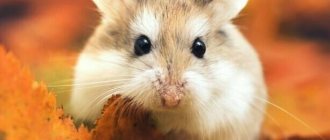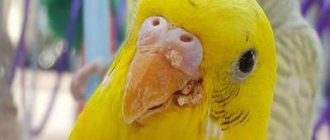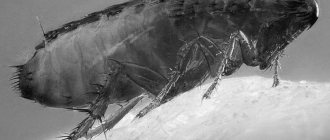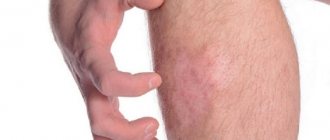Do chinchillas have fleas?
Chinchillas are friendly, undemanding pets.
Animals get sick a little and do not need special care. However, chinchillas sometimes have fleas. For their owners, this information often comes as a surprise. After all, animals are kept in comfortable, homely conditions and do not leave their home.
Also, many believe that chinchillas do not have fleas because rodents have thick fur and bathe in sand. Indeed, animals do not have their own parasites. But pests can be brought in from the street by cats or dogs.
Other routes of infection:
- fleas enter the house by clinging to people's shoes or clothing.
- Attics or basements are favorite habitats for blood-sucking insects. Through cracks and small openings, parasites easily enter a person’s home.
- Sometimes an animal may already be infested with fleas, for example, in a pet store.
- Parasites are often found in hay that is placed in a rodent's cage.
After landing on the body of the intended host, the insects find places where there is the least amount of hair. These are ears, muzzle or paws.
Non-contagious diseases of chinchillas
There are also diseases that cannot be transmitted from pet to owner. It's not about their animal origin. It is ironic that these arise mainly due to the fault of the owner, due to his inability to create suitable conditions of detention.
Below we will consider diseases that are classified as non-communicable.
Cold
In chinchillas, colds occur in case of hypothermia or blowing - exposure to a draft, moving the house to a cool room. When a chinchilla has a cold, it breathes heavily, its nose becomes wet, and sneezing and coughing appear.
To cure a cold, the owner will have to give the chinchilla an injection. The pet is given a five-day course of antibiotics.
Stress
Stress can appear after experiencing shocks. A stressful state is dangerous due to the possible development of more serious problems and diseases that can lead to the death of a pet. To overcome it, you will have to reconsider your pet’s life and start paying more attention to it.
Many chronic diseases and complications can develop from stress. Sometimes a chinchilla has a stroke due to stress, and sometimes serious pathologies appear.
Heatstroke
Such a nuisance can occur after overheating - for example, prolonged exposure to the sun. Emergency help in this case is to move to the shade and cool with a moistened (but not wet) towel.
Checking your chinchilla for fleas
Fleas prefer warm, moist places to live, ideally the fur of warm-blooded animals. This applies to the most common types of parasites - cat and dog bloodsuckers, which are no different from each other in their lifestyle. At the same time, they lay eggs on litter and other warm, hidden places. Having brought a playful, affectionate animal into your home, immediately carry out a preventative examination. Especially if he itches and bites the skin. Blood-sucking insects prefer to live on the legs and ears, since there is less fur there compared to the body. If there are no fleas, the skin is clean, smooth, without ulcers or scratches. If the above signs are found, this indicates the presence of parasites.
Important! The assumption that chinchillas do not have fleas is wrong. Their fur is thick and their love of swimming in the sand is considered a good prevention of their appearance. However, if there are insects in the apartment, chinchilla infection is inevitable!
Why does a chinchilla itch or bite itself and what to do about it?
If you periodically notice your chinchilla itching, do not immediately sound the alarm. All animals do this sometimes, but if the animal bites itself and itches constantly, examine it. The condition of the rodent's skin determines whether it needs the help of a veterinarian, or whether a minor correction of care is sufficient.
If the chinchilla does not lose hair, it has clear skin without redness, blisters or peeling; it may itch due to the dry air in the room. In this case, limit bathing in the sand to once a week or use a humidifier. Otherwise, you need to show the animal to a specialist and carry out the treatment recommended by him.
How fleas get into an apartment
If you are interested in the question of why your chinchilla itches and bites itself, check it for fleas, even if it is the only animal in the house. After all, bloodsuckers can get into a city apartment or private house in several ways:
- flea larvae or young, active insects can be carried on clothes and shoes;
- through ventilation shafts, openings;
- with sand and food, even purchased in a store;
- and the most common option is with pets who prefer warm, damp places for walking - basements, attics, sheds.
Important! If fleas are detected, you should start fighting immediately, because one mature individual lays a large number of eggs per day, which, under favorable conditions, turn into an adult insect within a few days.
How do chinchillas get fleas?
Can a chinchilla get fleas if it is always in a cage and not in contact with other animals? This question worries many owners of cute animals. In fact, bloodsuckers can settle on the thick skin of the animal:
- jumping over other pets;
- coming from attics, basements;
- from sand or hay, which are used for bathing, animal bedding;
- from carpets, upholstered furniture and other items in the house, if the room was infested with fleas even before the animal appeared;
- having settled on an animal in a pet store or market.
Important! Dogs and cats are the main sources of the spread of blood-sucking insects, especially if they are outdoors. Flea collars are not a 100% guarantee of sterility!
Can chinchillas become infected with Giardia?
Giardia is a type of microscopic parasite. It is the most common intestinal parasite found in chinchillas. There are several different types of Giardia. These parasites cause diarrhea, bloating and gas and can infect most pets.
Giardia can be found on surfaces, soil, food, or water contaminated with feces from an infected person or animal. Therefore, it can easily spread through groups of chinchillas.
Because Giardia parasites are microscopic, they cannot be seen in feces. The case can be diagnosed by a veterinarian through stool analysis. To make a diagnosis, the veterinarian will look for antigens specific to Giardia.
What to do if your chinchilla has fleas
Do not worry. This is a serious problem, but completely solvable. You need to go to the pharmacy and buy an anti-flea collar for kittens or small dogs. The use of drops such as “Bars”, “Stronghold” is fraught with poisoning : the rapid metabolism characteristic of rodents makes chinchillas very vulnerable to various chemicals.
Under no circumstances should you use anti-flea shampoos. In nature, chinchillas live in deserts and almost never encounter enough water to wet their fur. Bathing is a serious stress . In addition, the risk of catching a cold .
After putting a collar of a suitable size on the animal, you should proceed to measures aimed at exterminating fleas and their larvae in the home.
- Wash the chinchilla's cage with a solution of tar soap and vinegar.
- Change the sand in the sand bath.
- If there are other animals in the house, treat them for fleas too.
Carefully . If you remove the collar from the animal too early, it may become infected with fleas again. This happens for the reason that the parasite eggs, once on the floor, turn into larvae, which after 7-10 days give rise to a new generation of bloodsuckers.
To avoid re-infection , thoroughly wash the floors with a special product from a veterinary pharmacy. The floor treatment will need to be repeated after 1-2 weeks to destroy the newly hatched larvae and prevent them from pupating and laying eggs.
Inspection rules
To understand whether there is a problem, you need to examine your pet's paws and ears. In these places, the fur is sparse and the skin is thin. Sometimes parasites settle on the stomach and head. A flea can live on a chinchilla's back, but this area is the last area to become infected.
It is extremely rare to see parasites through fur. In the event of any threat, insects quickly hide in thick fur, so a person does not have time to notice them. However, brown feces and flea eggs can be seen on light-colored fur. The latter look like small dark grains.
You can understand that a chinchilla is infected by the following indirect signs:
- Itching. Appears in the early stages of a pet. It disturbs the animal even during sleep.
- Bites. Marks appear on the skin that can be confused with rashes.
- Deterioration in appearance. With severe infection, the body becomes depleted. The chinchilla is losing weight and losing hair.
- Anemia. With the development of anemia, the mucous membranes become pale.
Chinchillas have quite thick fur and it is very difficult to see the insect during inspection.
Symptoms of ectoparasite infection
Ectoparasites are parasites that live on the outer surface of the body of an animal or human. These include fleas, lice, and ticks. Chinchillas are infected with them relatively rarely due to their dense fur, but this possibility cannot be excluded until examination and testing are carried out.
The presence of parasites is detected by characteristic symptoms:
- the animal bites its fur, twitches and rubs its back against the wall;
- scratches the skin until it bleeds due to severe itching;
- the fur becomes brittle and falls out, especially on the head and paws, where it is less dense;
- bleeding ulcers and bumps appear on the skin;
- in serious cases there is swelling and suppuration.
Attention! If treatment is not treated promptly, the pet may die from exhaustion or blood poisoning.
How do symptoms appear?
The most obvious symptom is a sudden change in behavior. In the early stages, your chinchilla may become overly active. She runs around the cage restlessly and scratches herself. Irritability increases and aggression may appear. Later, due to poor sleep, the rodent becomes lethargic. His daily routine is disrupted. In severe cases, the pet develops apathy. He reacts poorly to attention, food and games.
Bites appear on the animal's skin. They may resemble rashes or warts. If an allergy to flea saliva develops, additional symptoms may develop. The chinchilla may experience discharge from the eyes, sneezing, etc.
Hair loss in an animal may indicate the presence of fleas.
How dangerous are parasites for animals?
If fleas are not removed from a chinchilla for a long time, then the parasitism of insects leads to the development of a number of adverse consequences. Sometimes the saliva of pests causes allergies in rodents. The condition is manifested by swelling, redness, irritation, and itching in the bite area.
With constant scratching of the skin, the animal can cause a secondary infection, which will lead to the development of inflammation or purulent processes. In addition, fleas are carriers of a number of dangerous diseases, worms, ticks and other types of pests.
With prolonged parasitism of blood-sucking insects on the chinchilla's body, the animal may develop anemia.
With anemia, the rodent becomes inactive, stops playing, eats poorly, and sleeps restlessly.
How to remove fleas from a chinchilla
Veterinarians and owners of furry rodents who have encountered a similar problem know what to do if a chinchilla has fleas. Removal of blood-sucking insects consists of two stages. First, the animal and its cage are disinfested.
Further, if necessary, measures are taken that involve the use of antiparasitic agents.
To get rid of fleas forever, you need to disinfect the entire house. For treatment, you can use special insecticidal or folk remedies.
Other important detoxification activities:
- washing of all bedding and rugs.
- Treating other domestic animals with insecticides.
- Applying antiparasitic agents to all secluded places (floor, baseboards, furniture).
During detoxification procedures, it is necessary to remove animals and people from the home. Several hours after treatment, ventilate the premises, wash floors, surfaces or vacuum them.
For the complete disappearance of fleas, repeated antiparasitic measures are recommended.
Processing the cage and animal
To get rid of pests forever, it is not enough to know how to remove fleas from a chinchilla. For the absolute destruction of insects, the use of insecticides or collars is not enough.
To prevent pests from appearing in your pet again, you need to thoroughly clean the animal’s cage.
For this purpose, the following activities are carried out:
- Sweep out all the trash (droppings, crumbs, leftover food).
- Change hay and sand.
- Treat the cage with a mixture of tar soap and vinegar.
- Boil the litter and disinfect it.
After treatment, it is advisable to place the chinchilla cage in the open air for 2-3 hours. Moreover, it is advisable to place it under the sun's rays.
Antiparasitic agents
After disinfecting the apartment and cage, it is necessary to take the animal to the veterinarian for examination. The doctor will examine the animal and then advise how to rid the chinchilla of fleas.
Often, if parasites are present, the doctor prescribes drops or sprays. Frontline is considered an effective remedy for blood-sucking pests. The drug is produced in the form of a spray or drops, which are used in a minimal dosage.
Other popular flea treatments for chinchillas:
- Advantage (drops);
- Fogger (spray);
- Lawyer (drops);
- Canina Bio (biospray);
- Le Artis (spray);
- Bars (spray);
- Palladium (spray);
- Butoxept (spray).
The chinchilla is a small animal that is very sensitive to chemicals. Therefore, the use of toxic agents in large doses can cause intoxication in a rodent.
The dosage of any antiparasitic agents should be minimal. Veterinarians recommend using doses intended for kittens or puppies.
For those who do not want to take risks in order to prevent rodent poisoning, doctors recommend that they refrain from using chemical antiparasitic drugs. You can simply put a collar on the rodent. It will not harm the chinchilla, as it is considered a less toxic product.
Also, veterinarians do not recommend using pest control shampoos.
After all, the natural habitat of chinchillas is the desert. Rodents never wash themselves. Moreover, water can accumulate in the animal’s dense fur. This will increase the likelihood of your pet getting a cold.
Video
How to remove a chinchilla cage.
The main parasites of chinchillas
There are several types of ectoparasites that are found in chinchillas.
Fleas
These wingless insects jump high and cling to animal fur with their claws and bristles. The flea's body length ranges from 1 to 5 mm, and its mouthparts are designed to pierce the host's skin and feed on blood. They carry pathogens of dangerous diseases such as typhoid, plague, and hepatitis.
Chinchillas can become victims of cat, rabbit and rat parasites. When infected with fleas, the animal itches, hair falls out, and bites resembling warts appear near the face and on the limbs. Insects can be detected by parting the fur.
Lice and lice eaters
Both types of parasites live in the fur of mammals; the sizes of individuals vary from 0.5 to 10 mm. Lice feed on blood, and lice eaters feed on blood and skin particles. They reproduce quickly, laying white eggs - nits that stick tightly to the hair.
These insects also carry infections that are dangerous to people and pets. Their bites cause severe itching and anxiety in animals, as well as scratching on the skin.
Ticks
Chinchillas are parasitized by subcutaneous and ear mites that live in the upper layer of the epidermis. Because of them, bumps, peeling and crusts appear on the skin, the animal often itches and experiences severe discomfort.
The diagnosis is made after microscopic examination of the scraping. Curing a pet from ticks is quite difficult and is often possible only in the initial stages: first, the animal is cut, then washed in a 0.5% bromocyclene solution 4 times at intervals of 8 days.
Can chinchillas get tapeworms?
Tapeworms are another type of worm; they don't look the same, but they do the same thing. They are flat and ribbon-like. Again, they do infect pets, but again, it is almost impossible for them to affect your chinchillas.
From a medical point of view, these worms are somewhat more dangerous than roundworms. This is because they can grow much larger. The larger the worm, the more it affects the digestive system of the host animal. While the host still absorbs most of the nutrients from its food, the worm takes a larger and larger share. Over time, this deficiency accumulates and the animal may lose weight.
There are also species found inside humans that could potentially be transmitted to pets. One particular species is known as the "rat tapeworm." It spreads when its eggs are ingested by insects and the animal eats the insect. The eggs can then be passed through the feces to begin the cycle again. Chinchillas can eat insects, although unless you hand feed them, it is unlikely that they will find and eat an infestation.
Ringworm or fungus in chinchillas
If your pet itches and bites itself, the cause may be a fungal skin disease - ringworm, or ringworm. Signs that distinguish the disease:
- hair loss in certain areas;
- peeling of the skin;
- formation of crusts and red spots;
- sometimes discharge of pus from wounds.
A chinchilla usually easily tolerates the disease, but if it is neglected, the animal can become completely bald, and the fungus can also affect other organs.
Diagnosis is carried out using an ultraviolet lamp in a dark room: with dermatomycosis, areas of the skin glow green. This test does not detect ringworm caused by some types of fungi; in such cases, skin and hair samples are taken for microbiological analysis.
Factors that increase the risk of disease:
- chronic stress;
- avitaminosis;
- malnutrition;
- high air humidity;
- poor hygiene;
- contact with the vector.
Ringworm is an unpleasant disease, but relatively easy to treat. Therapy is prescribed by a veterinarian; drugs such as clotrimazole, lamisil, exoderil, etc. are usually used. There is a vaccine against fungus that is administered to chinchilla puppies after 6 months.
Ringworm is easily transmitted to humans, so a sick animal should be isolated and touched only with gloves.
Gnawing fur
There can be many reasons for chewing fur. This could be a lack of vitamins, a bad mood, stress or dissatisfaction with the food. It is impossible to predict the cause, and it is impossible to stop chewing fur unless it is associated with any disease or stress.
Many delicate natures continue to gnaw fur throughout their lives. The only thing that can be done in this case is to protect against psychological stress and give all your love to this nervous animal. Perhaps, over time, the frequency of damage to your own wool will significantly decrease.
How to treat
To reliably get rid of fleas, it is not enough to treat only the chinchilla. Insects can remain in bedding and furniture, so comprehensive measures need to be taken. They start by treating the cell. The chinchilla is temporarily placed in another place. It is better to change the litter completely, but if this is not possible, you can remove debris from the old one, boil it and treat it with a disinfectant solution.
The easiest option is to grind tar soap into shavings, dissolve it in water and add a little vinegar. The entire cage and accessories are also treated with the liquid. Sand and hay are changed.
Houses are vacuumed well, moving furniture away and paying attention to upholstery. Bedding is washed in boiling water to kill the fleas. You can do the same with cat and dog bedding if you have any in the house. If it was not possible to get rid of the parasites and the infection recurs, you will have to treat with an insecticidal solution.
The most accessible and simple remedy is Bars spray. You may have to go somewhere for a day and take your pets to avoid intoxication. Sprays are used to treat the bottoms of beds and sofas, mattresses, crevices behind baseboards and kitchen cabinets, etc. After 10 days, the procedure is repeated to destroy the hatched individuals.
Special antiparasitic agents are produced for chinchillas. Some owners use medications for cats and dogs, but the dosage of active substances in them is different. This may cause side effects. It is recommended to use drugs for rodents; in extreme cases, a minimum dose should be given.
As an alternative, you can purchase a collar for cats and dogs. It contains less active substances. It is not recommended to use flea shampoos, because... A chinchilla may catch a cold after bathing. If there are other animals in the house, they also need to be treated.
One of the options for protecting against fleas is to put a parasite collar on your chinchilla.
Treating a rodent for fleas
Only large-scale disinfection measures will allow you to get rid of fleas not only on the animal’s skin, but throughout the entire apartment. Immediately after detection, it is necessary to remove all inhabitants from the house and carry out disinfection with special preparations - spray or aerosol. You need to carefully treat the areas behind the baseboards, floor cracks, carpets, and upholstered furniture. After this, the apartment is thoroughly cleaned with washing and using a vacuum cleaner. All pets are also treated with insecticides and wearing flea collars.
Chinchillas have fleas, what not to do?
- Use anti-parasitic shampoos designed for larger pets.
- Bathing an animal, for which getting its fur wet can result not only in serious stress, but also a cold.
- Use chemicals such as Bars or Stronghold, which can cause poisoning.
Important! 1-2 treatments of the apartment will be enough for the insects to disappear!
Flea remedies
When using antiparasitic products intended for cats and dogs, it is worth keeping in mind that the chinchilla is much smaller in size than other pets. This means that the dose of the chemical must be reduced. Special sprays and drops can cause significant harm to the animal. Therefore, the best option would be a special collar that is used for cats and dogs. The product is less toxic compared to chemicals and safe for health.
How to get rid of parasites
Never try to cure a chinchilla of parasites on your own using popular pet medications. At best, this will not bring results; at worst, the wrong dosage will lead to poisoning. The veterinarian must make a diagnosis and prescribe the necessary medications.
When treating fleas, a special collar for pets is successfully used. If your chinchilla is infested with insects and there are dogs or cats in the house, they should also be treated.
To get rid of parasites, be sure to disinfect the enclosure, change the filler, bedding and sand. It is also necessary to clean the entire apartment.
Preventive examination
As soon as the animal gets into your home, carefully examine its paws and ears. The fur on these parts of the animal’s body is much less dense than on the body, and parasites prefer to feed there. The skin is clean, no ulcers or scratches found, no insects? Everything is fine. Your animal is healthy.
You can tell that a chinchilla has fleas by indirect signs:
- The chinchilla experiences constant itching and cannot sleep peacefully. Losing weight.
- Dermatitis appears on the skin.
- The fur is falling off.
- Black specks are visible in the fur - flea droppings.
- Anemia occurs - the nose, gums and other mucous membranes turn pale, the animal weakens.
Attention. Many believe that chinchillas do not have fleas, since the thickness of their fur and love for swimming in fine sand prevent parasites from settling in their fur coat. But it is not so. They do not have their own parasites, but cat and dog fleas brought in from the street do not bypass any potential hosts.
Fur abrasion
Often, while walking or begging, a chinchilla may rub its muzzle or sides against some objects. It would seem that there is nothing wrong with it, but a chinchilla can simply erase or even tear out its fur by the roots, leaving only uneven shreds.
You can cope with this only by weaning the animal from its bad habit. If you can’t do this, all that remains is to add special fur supplements to food or water and lubricate the damaged surface with products for skin and fur. Just do not use iodine, since in addition to the fact that it is contraindicated for chinchillas, its composition will color the fur brown until the next molt.
Can a person become infected from a sick animal?
Humans can only become infected by fleas of the species Pulex irritans. Therefore, there is a chance of becoming infected with parasites, but it is very small. You may also simply be a carrier of these insects. But you should still be careful, as the flea can carry plague and rabies. Therefore, it is important to regularly carry out preventive measures.
Sources
- https://parazitdoma.ru/blohi/u-shinshilly-chto-delat
- https://klopkan.ru/blohi/vsyo-o-blohah/byvayut-li-blohi-u-shinshill/
- https://hlopklop.com/blohi/blohi-u-shinshill.html
- https://lifeinsect.ru/blohi-u-shinshilly.html
- https://homjakam.ru/shinshilla/zdorovie/cheshetsya-ili-pokusyvaet-sebya
- https://combat-dez.ru/prichiny-i-simptomy-poiavleniia-bloh-y-shinshill/
- https://stop-klopam.ru/blohi-u-zhivotnyh/chto-delat-esli-u-shinshilly-poyavilis-blohi
- https://pets2.me/bok/1629-kak-vyvesti-bloh-u-shinshilly.html
[collapse]











